Previous FI Curriculum – Ch. 6
-re verbs (regular)
Verbs with infinitives ending in -re form a third group of regular verbs, often called ‘third conjugation’ verbs. To form the present tense conjugations of these verbs, drop the -re from the infinitive and add the third conjugation endings (-s, -s, -, -ons, -ez, -ent) to the resulting stem. As you listen, note especially that the final -d and -ds in the singular forms are silent. In the third person plural the ‘d’ consonant sound of the stem is pronounced because of the -ent ending. Can you hear the difference in the pronunciation of the singular and plural forms of the third person? (il vs. ils).
| descendre ‘to go down’ | |
| je descends | nous descendons |
| tu descends | vous descendez |
| il/elle/on descend | ils/elles descendent |
| past participle: descendu | |
Here is a list of common regular -re verbs:
| attendre | to wait for |
| dépendre de | to depend (on) |
| entendre | to hear |
| pendre | to hang |
| perdre | to lose |
| rendre | to hand in, give back |
| rendre visite à quelqu’un | to visit someone |
| répondre | to answer, respond |
| vendre | to sell |
Not all verbs ending in -re follow this pattern, however. Irregular -re verbs include prendre, mettre, suivre and vivre.
| Un flic descend la rue. Tex panique et file. | A cop is coming down the street. Tex panics and runs off. | |
| Agent de police: Attendez! Attendez … Monsieur, vous vendez des T-shirts? | Policeman: Wait! Wait…Sir, are you selling t-shirts? | |
| Tex répond: Euh, oui, monsieur l’agent. | Tex answers, “Yes, sir.” | |
| Agent de police: Vous n’avez pas de permis. Hé, hé, vous êtes déporté. | Policeman: You do not have a permit. Hey, hey, you are deported. |
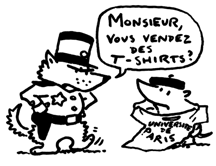
Listening Comprehension:
1
2
3
4
5
6
7
8
9
10
11
12
contractions of à and de with definite article
The prepositions à or de contract with the definite articles le and les to give the following forms:
- de + le = du
- de + les = des
- à + le = au
- à + les = aux
La and l’ on the other hand do not contract after à and de. Note that these contractions also occur with two- and three-word prepositions ending with à or de (jusqu’à, près de, loin de, à côté de, etc.).
| Tammy et Bette sont dans un café près du campus, à côté des commerces, pas loin de la tour. | Tammy et Bette are in a café near campus, not far from the stores, not far from the Tower. | |
| Tammy: Je vais prendre un thé à la vanille et un muffin au chocolat. Et toi? | Tammy: I am going to have a vanilla tea and a chocolate muffin. What about you? | |
| Bette: Pour moi, un biscuit aux amandes et un café au lait. | Fiona: For me, an almond cookie and a latte. | |
| Tammy: Bon, demain on va au gymnase, hein? | Tammy: And tomorrow we’ll go to the gym, eh? |
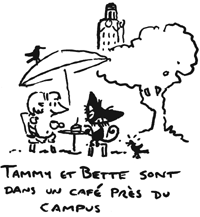
demonstrative determiners
forms
Demonstrative determiners (‘this’, ‘these’, ‘that’ or ‘those’) are used to point out things or people. They are also sometimes called demonstrative adjectives (in French ‘adjectifs démonstratifs’); they agree in number and gender with the noun they introduce.
| Masculine singular: ce Masculine singular before a vowel sound: cet |
ce tatou cet écureuil |
this armadillo this squirrel |
| Feminine singular: cette | cette chatte | this cat (female) |
| Plural (masculine or feminine): ces | ces tatous ces écureuils |
these armadillos these squirrels |
Note that liaison is compulsory between ces and words starting with a vowel or a silent h.
uses
In general, demonstrative determiners designate something one can see or show:
| Tex explique: Ce bassin, c’est Barton Springs. Cette piscine s’appelle Deep Eddy. | Tex explains: This pool is Barton Springs. This swimming pool is Deep Eddy. |
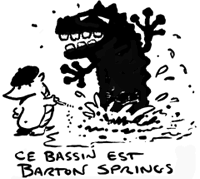
-ci and -là
Demonstrative determiners can designate something close or far away: in order to distinguish between two or more elements, you can add the suffixes -ci or -là to the demonstrative determiner. The suffix -ci indicates that the item is relatively near to the speaker; -là suggests that something is farther away. In English, they are generally translated by ‘this’ and ‘that’:
| Tex: Tu vois Tammy, cette étoile–ci s’appelle Vénus. Mais ces étoiles–là, c’est la Voie lactée. | Tex: See Tammy, this star (here) is called Venus. But those stars (there), are the Milky Way. | |
| Tammy: Venus … la voie lactée … oh Tex, j’aime bien quand tu me parles d’astronomie! | Tammy: Venus … the Milky Way … oh, Tex, I like it when you talk to me about astronomy! |
Listen to the dialogue:
| Tex et Tammy sont dans le rayon femmes de J. C. Penney. | Tex and Tammy are in the women’s section of J. C. Penney. | |
| Tammy: Qu’est-ce que tu penses de ce maillot-ci? | Tammy: What do you think of this bathing suit? | |
| Tex: Ah non! Je n’aime pas du tout cette couleur. | Tex: Oh no! I don’t like this color at all. | |
| Tammy: Et ce bikini? Ce sera parfait pour cet été. Tu ne trouves pas? | Tammy: What about this bikini? It will be perfect for this summer, don’t you think? | |
| Tex: Quelle horreur! Ce tissu est complètement démodé! | Tex: It’s horrible! This fabric is completely outdated! | |
| Tammy: Mais Tex, tu n’as aucun goût! Tu crois que ce vieux béret que tu portes est à la mode? | Tammy: Tex, you have no taste whatsoever! You think that this old beret you wear is fashionable? |

passé composé with avoir
uses
The passé composé is the most commonly used tense to refer to actions completed in the past. The passé composé may be translated into English in three different ways depending on the context.
| Tex a mangé toute la viande! | Tex ate all the meat!
Tex has eaten all the meat! Tex did eat all the meat! |
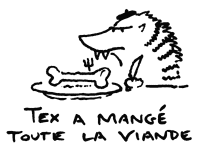
formation
This tense is called the passé composé because it is composed of two elements: the present tense of an auxiliary verb (either avoir or être), followed by a past participle:
passé composé = present tense of auxiliary + past participle
Note that in most instances the auxiliary verb is avoir, but some verbs require être as the auxiliary.
For regular verbs with an infinitive ending in -er, the past participle is formed by replacing the final -er of the infinitive with -é. Listen carefully to the pronunciation of the passé composé of the verb ‘parler’. The past participle (parlé) is pronounced the same as the infinitive (parler), even though they are spelled differently.
| parler ‘to talk’ | |
| j’ai parlé I (have) talked |
nous avons parlé we (have) talked |
| tu as parlé you (have) talked |
vous avez parlé you (have) talked |
| il, elle / on a parlé he, she (it) / one (has) talked |
ils / elles ont parlé they (have) talked |
The past participle of regular verbs with an infinitive ending in -ir is formed by dropping the final -r from the infinitive. For example, the past participle of finir is fini.
| finir ‘to finish’ | |
| j’ai fini I (have) finished |
nous avons fini we (have) finished |
| tu as fini you (have) finished |
vous avez fini you (have) finished |
| il, elle / on a fini he, she (it) / one (has) finished |
ils / elles ont fini they (have) finished |
The past participle of regular verbs with an infinitive ending in -re is formed by replacing the final -re of the infinitive with -u. For example, the past participle of perdre is perdu.
| perdre ‘to lose’ | |
| j’ai perdu I (have) lost |
nous avons perdu we (have) lost |
| tu as perdu you (have) lost |
vous avez perdu you (have) lost |
| il,elle / on a perdu he, she (it) / one (has) lost |
ils / elles ont perdu they (have) lost |
Note that many verbs, however, have irregular past participles. The past participles of many common irregular verbs which have avoir as an auxiliary are listed below.
| infinitive | translation | past participle |
| avoir | to have | eu |
| être | to be | été |
| faire | to do | fait |
| ouvrir | to open | ouvert |
| prendre | to take | pris |
| mettre | to put | mis |
| suivre | to follow | suivi |
| boire | to drink | bu |
| croire | to believe | cru |
| voir | to see | vu |
| savoir | to know | su |
| connaître | to know | connu |
| dire | to say | dit |
| lire | to read | lu |
| écrire | to write | écrit |
| pouvoir | to be able to | pu |
| vouloir | to want | voulu |
| devoir | to have to | dû |
| tenir | to hold | tenu |
| recevoir | to receive | reçu |
negation
Negation of the passé composé is formed by placing ne … pas around the conjugated verb, which, in this case, is the auxiliary avoir.
| Oh, regardez! Tex a mangé toute la viande! Tammy, au contraire, n‘a pas mangé de viande! Elle est végétarienne, comme la plupart des tatous. | Oh, look! Tex ate all the meat! Tammy, on the other hand, did not eat any meat! She is a vegetarian, like most armadillos. |
Listen to the following dialogue:
| Joe-Bob arrive chez Tammy. Il meurt de faim. Mais il est trop tard. | Joe-Bob arrives at Tammy’s house. He is dying of hunger. But it is too late. | |
| Joe-Bob: Tammy, j’ai perdu ma collection de noix. Est-ce que je peux dîner avec vous? | Joe-Bob: Tammy, I lost my nut collection. Can I have dinner with y’all? | |
| Tammy: Je suis désolée, Joe-Bob. Tex a fini toute la viande. A mon avis, il a trop mangé. | Tammy: I am sorry Joe-Bob. Tex finished all the meat. In my opinion, he ate too much. | |
| Joe-Bob: Ce n’est pas grave Tammy. Je peux trouver quelque chose dans la cuisine … Mon dieu, Tammy! Est-ce que tu as vu? Tex a dégobillé partout. C’est dégueulasse! | Joe-Bob: It’s okay Tammy. I can find something in the kitchen … My god, Tammy! Have you seen? Tex threw up everywhere. It’s disgusting! | |
| Tammy: Ça ne m’étonne pas. Ce petit tatou carnivore, il n’est pas aussi évolué que moi! | Tammy: That doesn’t surprise me. That little carnivorous armadillo. He is not as enlightened as I am! |

passé composé with être
uses
There are several past tenses in French, and each is used in very specific situations. The passé composé is the most common past tense; it is used to relate actions or events completed in the past. The passé composé may be translated into English in three different ways depending on the context.
| Tex est allé à l’Alamo. | Tex went to the Alamo.
Tex has gone to the Alamo. Tex did go to the Alamo. |

formation
The passé composé consists of two parts, the present tense of an auxiliary, or helping verb (either avoir or être), and a past participle. In most instances the auxiliary verb used is avoir.
passé composé = present tense of auxiliary + past participle
However, several intransitive verbs, like aller (to go), require the auxiliary être instead. Note that the past participle agrees with the subject in number and in gender.
| aller ‘to go’ | |
| je suis allé(e) I went (have gone) |
nous sommes allé(e)s we went (have gone) |
| tu es allé(e) you went (have gone) |
vous êtes allé(e)(s) you went (have gone) |
| il / on est allé he / one went (has gone) |
ils sont allés they went, (have gone) |
| elle est allée she went (has gone) |
elles sont allées they went, (have gone) |
The negation is formed by placing ne … pas around the conjugated verb, which in this case, is the auxiliary être: Je ne suis pas allé(e), Tu n’es pas allé(e), etc.
the Alamo of être
Many intransitive verbs, that is, verbs not followed by a direct object, take être in the passé composé. Many of these verbs also indicate motion. They are verbs of coming and going. Even naître (to be born) and mourir (to die) can be thought of as coming and going in metaphorical terms. The Alamo d’Être illustrates this group of verbs.
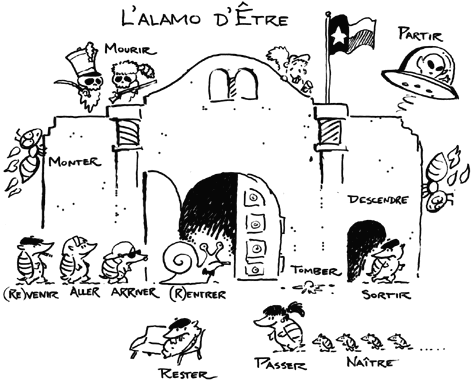
A few of these verbs of movement (monter, descendre, sortir, passer, retourner) may sometimes take a direct object, thus becoming transitive. When they do, the auxiliary used is avoir, instead of être. Example:
| Tex est sorti. | Tex went out. | |
| Tex n’a pas sorti la poubelle. | Tex did not take out the garbage. |
It is important to note that many intransitive verbs of movement, like courir and marcher, do not use être but avoir. The pronominal verbs form another important group of verbs which use être as the auxiliary in the passé composé.
irregular past participles
The past participles of the verbs that use être as an auxiliary are regular except for the following:
| infinitive | translation | past participle |
| venir | to come | venu |
| devenir | to become | devenu |
| revenir | to come back | revenu |
| naître | to be born | né |
| mourir | to die | mort |
agreement of the past participles
The past participle of a verb which takes être agrees in gender and number with the subject; that means an –e is added to the past participle to agree with a feminine subject and an –s is added for a plural subject. If the subject is feminine plural, –es is added.
| Joe-Bob: Tex, Corey et toi, vous êtes rentrés de l’Alamo? | Joe-Bob: Tex, did you and Corey come back from the Alamo? | |
| Tex: Oui. Mais Tammy et Bette sont restées à San Antonio pour faire des achats. | Tex: Yes. But Tammy and Bette stayed in San Antonio to go shopping. | |
| Corey: Tu n’as pas entendu? Tout d’un coup Tammy est devenue toute pâle et elle est tombée dans la rivière! | Corey: Didn’t you hear? All of a sudden Tammy turned very pale and she fell in the river! | |
| Joe-Bob: Mais, qu’est-ce qui s’est passé? | Joe-Bob: But, what happened? | |
| Corey: Calme-toi. Elle n’est pas morte! Tex et moi sommes arrivés pour la sauver! | Corey: Calm down. She didn’t die! Tex and I arrived to save her! |

